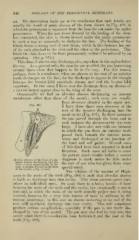Page 930 - My FlipBook
P. 930
940 DISEASES OF THE PERIDENTAL MEMBRANE.
est. My observation leads rae to the conclusion that such fistulse are
usually the result of acute abscess of the form shown in Fig, 489, in
which the periosteum is separated from the bone far out under the nialar
prominence. When the new tissue formed by the healing of the sinus
has contracted, the skin is drawn inward under the malar prominence
in such a way as materially to disfigure the face. The healing of the
fistula forms a strong cord of new tissue, which in this instance has one
of its ends attached to the skin and the other to the periosteum. This
binds the skin down to the bone permanently unless it be relieved by an
operation. (See p. 952.)
This class of abscess may discharge, also, anywhere in the region below
the eye. As a general rule, the muscles are avoided, the pus burrowing
around them when they happen to lie in the way. For this reason,
perhaps, there is a tendency, when an abscess at the root of an anterior
tooth discharges on the face, for the discharge to appear in the triangle
between the levator labii superioris alseque nasi and the levator labii
superioris. In two cases I have seen the discharge from an abscess of
a central incisor appear close to the wang of the nose.
Occasionally we find an alveolar abscess discharging on mucous
membranes other than those of the mouth ; such cases are usually
from abscesses situated in the upper jaw.
I have three times seen abscesses at the
root of the incisors discharging into the
nasal cavity (Fig. 497). In these instances
the pus passed through the bone, and in
each instance the abscess-cavity was very
large. I have also met with one instance
in which the pus from an anterior tooth
passed back beneath the mucous mem-
brane and discharged at the junction of
the hard and soft palate. Several cases
of this kind have been reported in dental
literature. Such cases are liable to cause
the patient much trouble before a correct
Alveolar Abscess at the Root of a Su- diagnosis is made unless he falls under
perior Incisor discharging into the the care of one wdio has given them some
Nose : a, large abscess-cavity in the
bone ; 6, mouth of fistula on the floor special study.
of the nostril ; c, lip ; (/, tooth.
The relation of the antrum of High-
more to the roots of the teeth (Fig. 498) is such that alveolar abscess
is liable to discharge into that cavity. This sinus presents great vari-
ations in individual cases. In some there is a heavy lamina of bone
betMcen the roots of the teeth and the cavity, but occasionally a case is
met with in which the roots of the teeth actually project into it, being
covered, however, by a very thin lamina of bone in addition to the
nuicous membrane ; in this case an abscess occurring at the end of the
root will inevital)ly discharge into that cavity. This will sometimes
produce serious complications, especially if the pus is not freely dis-
charged by way of the nostril. The pus may also find its way into this
cavity when there is considerable bone between it and the root of the
tooth (Fig. 499).


